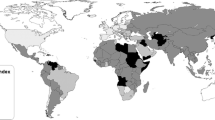Abstract
Recent studies have identified various negative effects of public sector corruption. We add to these by considering the association between corruption and deaths due to major earthquakes. After developing a brief theoretical model of the relation between these two variables we test the proposition by analyzing 344 quakes occurring between 1975 and 2003. The empirical model takes into account the endogeneity of corruption and controls for factors, such as earthquake frequency, magnitude, distance from population centers, and a country’s level of development which influence quake destructiveness. The results indicate that public sector corruption is positively related to earthquake deaths.
Similar content being viewed by others
References
Alesina, A., & Weder, B. (2002). Do corrupt governments receive less foreign aid? American Economic Review, 92, 1126–1137.
Anbarci, N., Escaleras, M., & Register, C. (2005). Earthquake fatalities: The interaction of nature and political economy. Journal of Public Economics, 89, 1907–1933.
Anbarci, N., Escaleras, M., & Register, C. (2006). Traffic fatalities and public sector corruption. Kyklos, 59, 327–344.
Anderson, G., & Tollison, R. (1991). Congressional influence and patterns of New Deal spending, 1933–1939. Journal of Law and Economics, 34, 161–175.
Bardhan, P. (1997). Corruption and development: A review of issues. Journal of Economic Literature, 35, 1320–1346.
BBC News. (2001, January 29). Press blames corruption for quake losses. http://www.news.bbc.co.uk/2/hi/world/monitoring/media_reports/1142765.stm.
Beck, P., & Maher, M. (1986). A comparison of bribery and bidding in thin markets. Economics Letters, 20, 1–5.
Bliss, C., & Di Tella, R. (1997). Does competition kill corruption? Journal of Political Economy, 105, 1001–1023.
Bohlen, C. (1999, August 20). Turkish earthquake survivors blame corruption. New York Times. http://www.wakingbear.com/turkey1.htm.
Control Risks Group. (2002). Facing up to corruption. London: Control Risks Group.
Cooperative Institute for Research in Environmental Sciences. (2001). 26 January 2001 Bhuj earthquake, Gujarat, India. http://www.cires.colorado.edu.
Depken, C., & Lafountain, C. L. (2006). Fiscal consequences of public corruption: Empirical evidence from state bond ratings. Public Choice, 126, 75–85.
Dunbar, P., Bilham, R., & Laituri, M. (2002). Earthquake loss estimation for India based on macroeconomic indicators. In T. Beer & A. Ismail-Zadeh (Eds.), Risk science and sustainability: Science for reduction of risk and sustainable development of society. Dordrecht: Kluwer Academic Publishers.
Garrett, T., & Sobel, R. (2003). The political economy of FEMA disaster payments. Economic Inquiry, 41, 496–509.
Habib, M., & Zurawicki, L. (2002). Corruption and foreign direct investment. Journal of International Business Studies, 33, 291–307.
Huntington, S. (1968). Political order in changing societies. New Haven: Yale University Press.
International Association for Earthquake Engineering. (1996). Regulations for seismic design: A world list. Tokyo: IAEE.
International Conference of Building Officials. (1987). Uniform building code: Structural engineering design provisions. Whittier, CA: ICBO.
Kahn, M. (2005). The death toll from natural disasters: The role of income, geography, and institutions. Review of Economics and Statistics, 87, 271–284.
Karahan, G., Coats, R., & Shughart, W., II. (2006). Corrupt political jurisdictions and voter participation. Public Choice, 126, 87–106.
Kinzer, S. (1999, August 17). The Turkish quake’s secret accomplice: Corruption. New York Times. http://www.library.cornell.edu/colldev/mideast/tquak.htm.
Knack, S., & Keefer, P. (1995). Institutions and the economic performance: Cross-country tests using alternative institutional measures. Economics and Politics, 7, 207–227.
La Porta, R., et al. (1999). The quality of government. Journal of Law, Economics, and Organization, 15, 222–279.
Leamer, E. E. (1985). Sensitivity analysis would help. American Economic Review, 75, 31–43.
Leff, N. (1964). Economic development through bureaucratic corruption. American Behavioral Scientist, 8, 8–14.
Levine, R., & Renelt, D. (1992). A sensitivity analysis of cross-country growth regressions. American Economic Review, 82, 942–963.
Lewis, J. (2005). Earthquake destruction: Corruption on the fault line. In Transparency International, Global corruption report 2005, pp. 23–30.
Leys, C. (1965). What is the problem about corruption? Journal of Modern African Studies, 3, 215–230. Reprinted in A. J. Heidenheimer, M. Johnston, & V. T. Le Vine (Eds.), Political corruption: A handbook, pp. 51–66. Oxford: Oxford University Press, Transaction Books, 1989.
Lien, D. (1986). A note on competitive bribery games. Economics Letters, 22, 337–341.
Mauro, P. (1995). Corruption and growth. Quarterly Journal of Economics, 110, 681–712.
Meon, P., & Sekkat, K. (2005). Does corruption grease or sand the wheels of growth? Public Choice, 122, 69–97.
Mo, P. (2001). Corruption and economic growth. Journal of Comparative Economics, 29, 66–79.
Pejhan, S. (2003, January 3). Ready for future Bam’s? The Iranian. http://www.iranian.com/Opinion/2004/January/Again/index.html.
Pellegrini, L., & Gerlagh, R. (2004). Corruption’s effect on growth and its transmission channels. Kyklos, 57, 429–456.
Schulze, W., Brookshire, D., Hageman, R., & Tschirhart, J. (1987). Benefits and costs of earthquake resistant buildings. Southern Economic Journal, 53, 934–951.
Serra, D. (2006). Empirical determinants of corruption: A sensitivity analysis. Public Choice, 126, 225–256.
Stansbury, N. (2005). Exposing the foundations of corruption in construction. In Transparency International, Global corruption report 2005, pp. 36–50.
Transparency International. (2003). Bribe payers index. In Global corruption report. London: Pluto Press.
Treisman, D. (2000). The causes of corruption: A cross-national study. Journal of Public Economics, 76, 399–457.
Turkish Daily News. (2006, August 8). Ministry takes over Bodrum’s building rights. http://www.turkishd ailynews.com.tr/article.php?enewsid =50947.
Wooldridge, J. (2002). Econometrics of cross section and panel data. Cambridge, MA: MIT Press.
World Seismic Safety Initiative. (2001). Interdisciplinary observations on the January 2001 Bhuj, Gujarat earthquake. http://www.rms.com/Publications/Bhuj_EQ_Report.pdf.
Author information
Authors and Affiliations
Corresponding author
Additional information
JEL Classifications: D31, H41, P16
Rights and permissions
About this article
Cite this article
Escaleras, M., Anbarci, N. & Register, C.A. Public sector corruption and major earthquakes: A potentially deadly interaction. Public Choice 132, 209–230 (2007). https://doi.org/10.1007/s11127-007-9148-y
Received:
Accepted:
Published:
Issue Date:
DOI: https://doi.org/10.1007/s11127-007-9148-y




